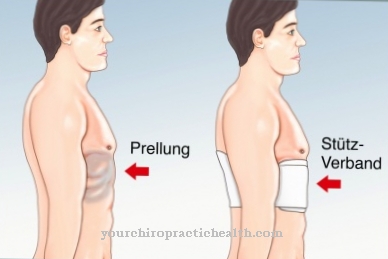A Enterostomy is an artificial anus on the abdominal wall for the temporary or permanent drainage of the intestinal contents, as may be necessary for colon cancer patients, patients with inflammatory diseases such as Crohn's disease or patients with intestinal sutures.
The procedure is usually carried out under general anesthesia and, in addition to the typical anesthetic risks, is primarily associated with the formation of internal hernias, which an experienced doctor can usually avoid through special preventive measures. Enterostomata either remain permanent or are relocated within a few weeks, especially if they are only intended to temporarily relieve a section of the intestine.
What is the enterostomy?

An enterostoma is an artificial anus on the abdominal wall for the temporary or permanent discharge of the intestinal contents.
The doctor calls one an enterostoma artificial anus in the abdominal wall, which is used to drain the intestinal contents. In this context, a stoma always corresponds to an artificially created hollow organ opening on the body surface. The red and moist enteric stoma protrudes from the abdominal wall and can either be applied permanently or as a temporary solution.
The doctor differentiates enterstomata into ileostomata, coecostomata, colostomata and transversostomata, depending on the section of intestine used. The ileostomy is the most common form and corresponds to an exit from the ileum. For this purpose, a deep loop of the small intestine is usually used, whereby the discharge usually takes place through the ceiling of the right lower abdomen. Both ileostomy and colostomy - an artificial colon outlet - can be created temporarily or permanently.
The special form of the transverse ostomy is again an artificial exit from the middle part of the colon, which can also be applied continuously or discontinuously. Finally, the doctor understands the coecostoma as a discharge from the appendix. In all cases, the surgical procedure for setting the enterstoma can be described as Enterostomy describe. This can be carried out either at the end or in two ways. A terminal implementation is necessary if parts of the intestine had to be removed beforehand.
A double-barreled enterostomy, on the other hand, is often used for intestinal sutures that temporarily require relief from the bowel. In Germany, it is estimated that more than 100,000 people of different age groups carry enterostomata.
Function, effect & goals
Various diseases can indicate an enterostomy. The procedure most often takes place in intestinal dysfunction, colon cancer patients or patients with hereditary colon polyp disease. However, carcinomas in a different location between the chest and pelvis can also make the procedure necessary, for example bladder or uterine cancer.
The intestine may also have been damaged by a previous trauma, so that the doctor had to remove parts of it, or an inflammatory disease such as Crohn's disease caused considerable damage to certain intestinal regions. The operation takes place under general anesthesia. Before the operation, the doctor draws the ideal position of the stoma on the patient, thus ensuring that the opening does not cause discomfort later on while sitting, lying or standing. As a rule, the doctor uses an abdominal incision, i.e. a laparotomy, for the laying.
If a major surgical procedure is not necessary, a minimally invasive procedure in laparoscopy, i.e. a laparoscopy, is used to relocate. In the case of a colostoma, the stoma is relocated without tension and in a slightly protruding position in the straight rectus abdominis muscle. The doctor fixes the colon mesentery to the abdominal wall. If an ileostomy is required, the doctor will route the supplying ostomy leg through the small intestinal protuberance with a downward orientation. He makes sure that the stoma protrudes several centimeters above the skin, otherwise the secretion of the small intestine can cause skin irritation.
A terminal enterostoma is sutured to the outside of the abdominal wall and is usually not relocated. A double-barreled stoma is usually relocated after a few weeks, as this procedure is only intended to relieve the strain on the bowel for a certain period of time. This operation differs from the procedure just described in that the functional intestine is removed from the abdominal wall incision and provided with the respective openings for the stoma.
In both a double-barreled and a terminal enterostomy, the relocated system corresponds to either a one-part or a two-part system. In a one-piece system, the skin protection plate and the bag form a unit. In a two-part system, on the other hand, the doctor attaches the plate and the bag separately to the ceiling of the abdomen.
You can find your medication here
➔ Medicines for stomach ailments and painRisks, side effects & dangers
In addition to the conventional risks of general anesthesia, an enterostomy is primarily associated with the risk of internal hernia formation, i.e. the passage of abdominal viscera through an opening in the abdominal wall. This can also lead to a displacement of organs from the abdomen through the stoma. If an intestinal prolapse has occurred, the stoma can no longer close tightly.
If the abdomen is folded in a sitting position, sores may appear after the operation as excretions collect in the folds. Under certain circumstances, the stoma can move back into the abdomen after the operation and thus disappear under the skin. Although these risks exist, the enterostomy is generally considered a relatively safe operation that is part of the everyday life of a surgeon. Before the operation, the extensive care of the patient by specialist staff plays a major role. This includes, for example, advice on the subsequent diet, which can only be built up again slowly and initially requires, for example, avoiding high-fat foods or hot spices.
Depending on the system chosen, the stoma is later equipped with either an open or a closed bag. Open bags are regularly emptied by the patient, while closed bags are thrown away and replaced with new bags. This procedure is also explained to the patient in advance by the specialist staff. If a move back is planned, an appointment can be made now. The misplaced stoma will be checked regularly after the operation to ensure that it does not slip below the skin level.
























.jpg)



